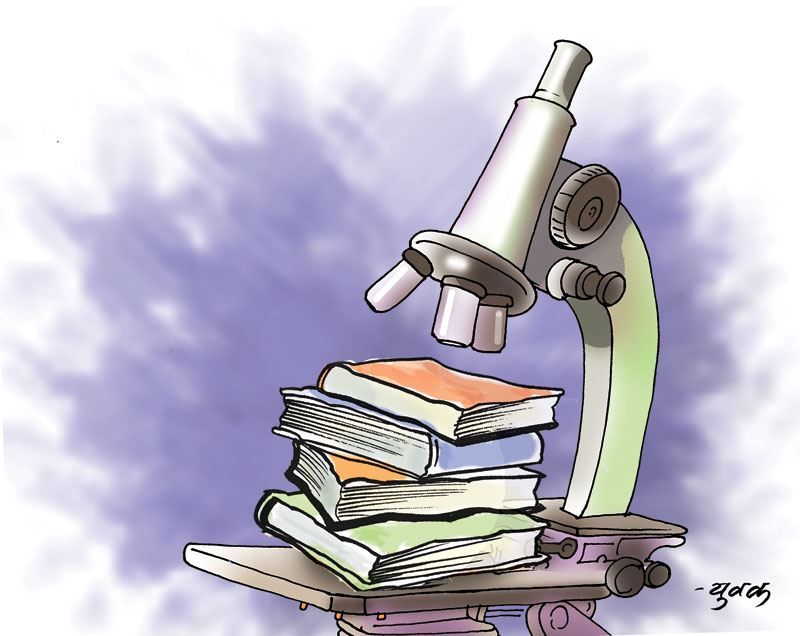
OR


Shyam Sharma
The author teaches writing and rhetoric at the State University of New York in Stony Brook. He can be reached at shyam.sharma@stonybrook.edughanashyam.sharma@stonybrook.edu
There is still no teaching-to-assessment alignment. The attempt to introduce new forms of assessment may have added new misalignments
Imagine that you want to join the army and the only thing the recruitment office has said is that “applicants must be strong and healthy.” Say there is no training center, no one who can actually prepare you for the test, and all you can do is to listen to stories from retired army officers in the village. You draw best inferences from their stories to develop general physical abilities and skills.
When you show up at the recruitment center, you are asked to climb a big, branchless tree.
Under the conventional lecture-and-exam system of higher education, too many students failed because they were never taught to summarize, analyze, apply, and solve issues “in writing” that they had to in the long exams at the end of the year. In fact, many students could not sufficiently understand content knowledge from primarily listening to lectures (from scholars who were literally called “lecturers”) and reading texts that were often too complex for them.
In the old system, neither teaching (T, primarily lecture) nor learning (L, primarily listening) were aligned well with exams (E, usually writing). The system was like a one-way traffic where subject knowledge (K) started moving from point T, went through L, and veered off the cliff at E. Public institutions usually ignored exam results; private colleges tried to improve the quality of teaching and learning, but they also got stuck in the culture of showing off results. But no one really updated the straight line and turned it into a cyclical loop where exam results were used to improve/update teaching method and learning process. Some teachers reviewed student performance in end-of-term assessment for rethinking future teaching, but they didn’t have to: it wasn’t a required and built-in aspect of the system.
The new semester-based system was implemented to disrupt the one-way traffic of teaching-learning-testing by inserting formative assessment during the academic term. Its primary method for affecting change is the transfer of some power and responsibility of assessment to teachers, so they can integrate formative assessment in the process of learning and teaching. But two major problems persist with the implementation of the semester system in Nepal.
First, even when formative assessment is used, it is still dominated by written exams. Exams are a specific—and usually problematic—method of assessment because while they are able to test students’ understanding of subject matter, they are far less able to assess academic abilities such as researching, presenting ideas, interactively engaging and persuading people . . . or skills such as using technological applications. Even when used during the academic term as a means of observing student performance, exams take assessment out of the context of however students are engaging with learning, formulating their own ideas, developing their disciplinary and professional identities. I will focus on this extremely important issue in future essays.
Second, even when new kinds of formative assessment are used during the semester, they are usually not taught. Note here the term assessment (as opposed to testing) as key, because it includes any method of checking whether and how well students are learning the content, acquiring skills, having transformative experiences. To reuse the analogy of joining the army, the second challenge added by semester system makes the gap between training and testing even bigger.
Imagine that you now can go to a village training center to prepare. This center makes you run five miles every day, eat more protein, and do a lot of pushups. When you go for the test, you are asked to not only climb a big, branchless tree but also to demonstrate various other complex physical and endurance skills. I will focus on this complex issue in my next essay.
Realizing the limitation of written examination, some institutions and teachers are trying to add different assessment tools, such as conducting research and writing papers, class presentations, collaborative projects, case studies, field work, and so on. These methods of assessment more naturally allow the integration of teaching with testing; for instance, when students make class presentations, teacher and fellow students provide instant feedback, helping the presenter learn while receiving credit for doing something.
However, as with written examination, few instructors take time to teach how to perform these highly specialized tasks—assuming instead that if students understand the subject matter, they can do the rest. In fact, these practices are new to most teachers themselves. Few have the training or experience, and many argue that students must have already learned these skills or should learn them somewhere else. So, most teachers just demand their students to demonstrate the skills, while using them as methods of assessment, determining their success or failure based on their ability to perform the tasks.
As such, there is still no teaching-to-assessment alignment. In fact, the attempt to introduce new forms of assessment may have added new misalignments. Learning activities that students are involved in (LA) are not the task they must do for assessment (TA). For instance, after involving students in a chemistry lab experiment done for figuring out the ideal combination and condition for a certain reaction, the teacher may evaluate students’ performance by asking them to write a lab report (not as stressful and unrealistic as exam), present findings in class (without teaching them the skills needed), or do a collaborative project (which may not have been part of the learning process). The teacher may still fail students for presenting “poorly written” papers.
To align teaching, learning, and assessment, teachers must be able to design learning activities that allow them to observe and give credit to students’ effort and learning. They must be able and willing to provide feedback in the process and let students use “grading” for continual improvement. And, most importantly, they must use assessment to inform their future teaching.
The idea of “internal” assessment—which currently involves leaving 25-40 percent of course credit in the hands of the teacher—was meant to help teachers better align teaching method with learning activities and task for assessment. But most teachers have not been using the power/opportunity given to them. They continue to use exams for all or most of the internal credit by arguing that that’s a necessary/effective way to prepare students for external exams. Instead of using internal marks to engage students in class discussion, presentation, collaboration, writing/communication activities, research, analysis of texts or issues, designing artifacts or projects, or developing new ideas and artifacts, most teachers only give a few points for “participation” and save the rest for “internal” exams.
There are many more justifications for letting final exams cannibalize internal assessment marks. It is hard to change students’ habit, some say. If students fail or get poor marks in external exam, they will blame the teacher for not focusing on the content or covering the course. Students’ interest to receive high marks trumps their interest in academic and professional skills. Others don’t want to be the odd man or woman out among colleagues. Student-engaged teaching doesn’t fit some subjects well. Yet others point to the lack of space, resource, or technology as preventing teachers from going beyond the lecture method. And there is the harsh reality of work load and time limitation for most teachers: it is hard to find time to prepare plans and materials for every class.
And yet, the greatest hurdle is related to teacher development: Teachers who have expertise, experience, and confidence to shift into new modes of teaching are far more able to overcome the hurdles. For example, teachers who know how to use internal grading to make students come to class having read the text to be discussed are better able to engage students in discussions and activities. They can also skip a few class meetings to make time for office hours. And they can get administrators and colleagues on board more easily.
Of course, the misalignment from teaching and learning to testing (which is severely undermining the attempted update in higher education through semester system) has challenges beyond the teacher’s and institutions’ control. But training, support, and incentives for teachers can get us quite a distance from where we are now.
Teacher development must also accompany leadership work, improved professionalization of teaching, and better alignment of academic success with professional growth of students. So I plan to follow up on these issues in future essays here. Stay tuned.
The author is an assistant professor of Writing and Rhetoric at Stony Brook University (State University of New York)
ghanashyam.sharma@stonybrook.edu
You May Like This

Zero student in masters' programs after semester system introduced
ILAM, July 31: Introduction of the semester system in masters' level programs by Tribhuvan University has affected student enrollment in campuses... Read More...

Enabling semester system
Unlike in annual system of education where teachers predominantly depended on lecture method of teaching and barely engage with students... Read More...

Semester system for master's level in all TU Valley campuses
KATHMANDU, March 14: Two years after the implementation of the semester system in the central departments of Tribhuvan University (TU),... Read More...




_20220508065243.jpg)
Just In
- MoHP cautions docs working in govt hospitals not to work in private ones
- Over 400,000 tourists visited Mustang by road last year
- 19 hydropower projects to be showcased at investment summit
- Global oil and gold prices surge as Israel retaliates against Iran
- Sajha Yatayat cancels CEO appointment process for lack of candidates
- Govt padlocks Nepal Scouts’ property illegally occupied by NC lawmaker Deepak Khadka
- FWEAN meets with President Paudel to solicit support for women entrepreneurship
- Koshi provincial assembly passes resolution motion calling for special session by majority votes













Leave A Comment